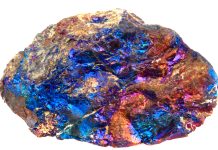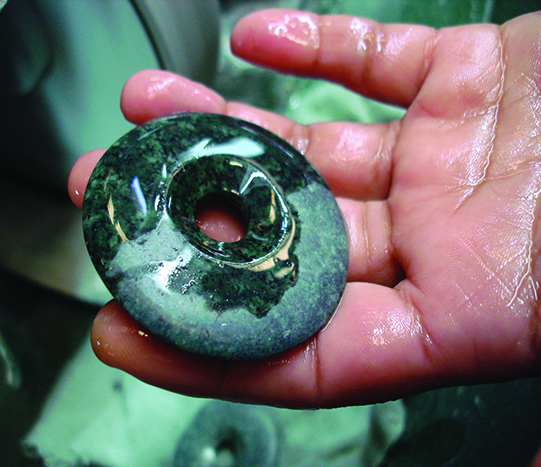
Guatemalan jade is a rare gem material that comes in many different colors. This jade was prevalent in ancient Mesoamerica, however, its sources were lost for five centuries. It was rediscovered less than 50 years ago.
Tourists visiting Guatemala today can go to shops that sell jewelry and art made from Guatemalan jade. Here in the United States, we rarely encounter jade from Guatemala as rough, slabs and jewelry so it can be difficult to understand and appreciate its value.
The Mayan World
In the Mayan world, jade was revered. This ancient culture flourished in the first millennium A.D. in Mexico and Central America. The Maya civilization stretched over what is known today as Guatemala, Belize, southern Mexico and the western regions of Honduras and El Salvador.
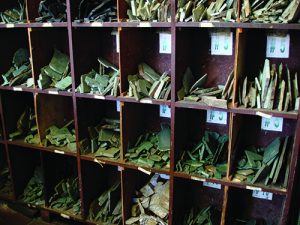
Great Maya city-states rose in the highlands and the jungle-covered lowlands. Metropolises, such as Tikal, Copan, Palenque, Uxmal and Chitzén Itzá, had royal courts, temple pyramids and enormous populations. The Mayas were passionate about architecture, astronomy, mathematics and the arts.
The Maya, just as their predecessors the Olmecs, held jade in the highest esteem. It was rare and valuable. It represented eternity. They buried their kings adorned with jade masks and pectorals, considering jade the ultimate passport to the afterlife.
For the Maya, green was the most precious color, including green rocks. Green represented the life-giving water of the Sacred Cenotes (natural underground cave systems and wells). Green symbolized crops and fertility. Besides burial masks, jade was carved into rings, ear flares, pendants, beads and ceremonial objects. Jade was also valued for its durability and its ability to take a high polish.
Jade Minerals
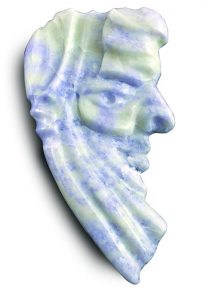
Jade is a generic term that describes several gem materials.
Nephrite is a massive rock consisting of felted, intergrown, fiber-like crystals of the minerals tremolite and actinolite. Nephrite is found in many places including China, British Columbia, Siberia, New Zealand and the United States. It occurs in many colors ranging from pure white to green to black. [Ca2(Mg, Fe)5Si8O22(OH)2]
Jadeite, the jade used by the ancient Maya, is composed mostly of the pyroxene mineral jadeite. The only other major source of jadeite in the world is Myanmar (Burma), where the famous translucent green “imperial jade” is found. There are also new sources found in Cuba and the Dominican Republic. [NaAlSi2O6]
Omphasite jade is a pyroxene that is roughly half jadeite and half diopside. It is the latest jade variety to be included in the internationally approved jade nomenclature in Hong Kong. [CaMgSi206]
Dark chloromelanite, the ferruginous variety, is an intermediate between jadeite and acmite. [NaFeSi2O6+]
Jade Name Origins
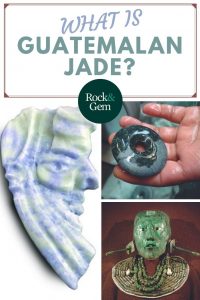
The English term jade is derived from the Spanish piedra de ijada or yjada (flank, side, hence loin stone or colic stone) because it was supposed to cure kidney ailments.
Latin scholars in 16th-century Europe coined the term Lapis nephriticus, which later became nephrite. Jadeite was identified as a separate mineral from nephrite by French professor, A. Damour in 1864.
Ironically, after all those years, the Spaniards’ “piedra de yjada” came to be known as jadeite.
Guatemalan Jade Colors
A magnificent variety of jadeite colors is now mined in Guatemala. Jadeite in every shade of green is collected, from a light mint color to a saturated dark green. Also found are white, creamy yellow and lavender or lilac.
A green-and-white mottled variety is known as Mayan Foliage. The rarest of all is the bright, translucent Imperial jade. Blue jade is another rare color.
Jade boulders of different colors can be found side-by-side in the field. Boulders can contain various colors.
Also discovered is a scarce variety named galactic gold, is a deep black jade that has flecks of precious metals – silver, nickel, cadmium, pyrite, platinum and gold.
Facts about Guatemalan Jade
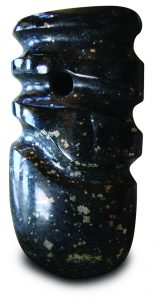
Guatemalan jade’s physical appearance is granular, with a greasy luster. Its hardness is about 7 on the Mohs scale of hardness. The refractive index is 1.65-1.67 and specific gravity of 3.20-3.34.
The Rio Motagua flows along the earthquake fault line between the North American and the Caribbean plates. Jade is formed deep in the earth’s crust and is pushed up under very high pressure and low-temperature conditions.
Arduous Mining Te3chniques
There is no underground mining of Guatemalan jade. Jade boulders are heated and then water is thrown onto the hot boulder to create cracks. Gasoline-powered jackhammers are used to remove jade ‘lenses’ from the boulders.
The hunt for jade is arduous. Jade boulders are also hard to identify because their surface is covered with a rind similar to the bark of a tree. Distinguishing jade in the field is done by pounding the rocks with a 10-pound sledgehammer. A unique ringing sound identifies the jade.
Jade is also tested in the field by submerging the specimens in a methylene iodide test fluid, blended to a specific gravity of 3.0. Jadeite will sink, while serpentine, nephrite and chrysoprase float.
How Guatemalan Jade Was Lost
The sources for Guatemalan jade were lost for the past five centuries because the Spanish conquistadores did not value jade. Reports from early Spanish explorers document the special status of a gemstone unknown to them, one that would later be called jade.
At the beginning of the Spanish conquest, the Maya people kept the location of their jade mines a secret to protect them from the invaders. Over time, the location of the ancient mines and quarries became forgotten and lost.
The Maya Jade Rediscovery Story
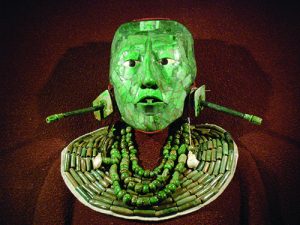
The story of Guatemalan jade rediscovery spans over a century. It involved many American scientists enamored with the jade. Among them were Zelia Nutall, William Niven, Robert Leslie, William Foshag and Tom and Joyce Barbour.
Carved jades had been found in archaeological sites in Mexico and Central America since the early 1900s. However, no jade specimens were found on-site until much later.
In the 1940s, American geologist, William Foshag, spent several years in Mexico and Guatemala. He studied the ancient jades and local geology. Foshag wrote that Robert Leslie had discovered jade in 1952 in the Motagua River Valley.
Foshag’s research categorized the Guatemalan jade as jadeite. He found it to be similar to jade found in Burma. This was the beginning of the rediscovery of the Maya jade mining sources.
An American expatriate couple, Jay and Mary Lou Ridinger, searched for the jade and found their first outcrop on a tributary of the Motagua River in 1974. They sent samples to the Gemological Institute of America (GIA) and other labs. All confirmed their finds as jade. They found lavender jade in 1998. In 2004, they found small amounts of translucent emerald green jade, which they call Maya Imperial Jade.
Mayan Lapidary Work
The Ridingers also found Mayan workshop sites with remnants of tools. We know the Maya did not have metal tools. The advent of copper tools with their ability to carry abrasive grit revolutionized hard gemstone carving in ancient Mesopotamia, Egypt and Greece.
So, how did the Mayan carvers do it? They carved jade with a wooden blade made from the local hardwood lignum vitae with an adhesive that could carry crushed garnet or jade as the abrasive.
Lapidary Work at the Jade Maya™ Shop in Antigua
Located in Antigua, Guatemala, Jade Maya™ is a gallery, archeology museum and factory for carving jade. It is the Ridingers’ original company.
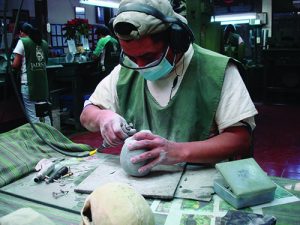
To set up the shop, Jay Ridinger brought lapidary equipment from the United States. Robert Terzuola, another American living in Guatemala and fine jade master carver, became the shop’s foreman for several years.
An impressive inventory of sorted jade slabs of all colors and grades is arranged on wooden shelves, immediately available for custom orders. All of the jade material is natural, not treated by dye, heat, or bleaching.
Skilled workmen carve beautiful replicas of ancient artworks, with motifs that reflect their artistic traditions.
The main carving area is a room in the center of the shop, where visitors can observe the carvers at work. Several lapidary units around the perimeter of the room are set up with rotating wheels for grinding and sanding.
This story about Guatemalan jade previously appeared in Rock & Gem magazine. Click here to subscribe! Story and photos by Helen Serras-Herman.




